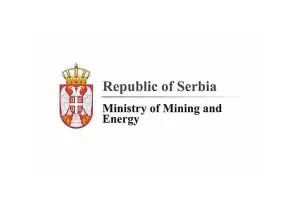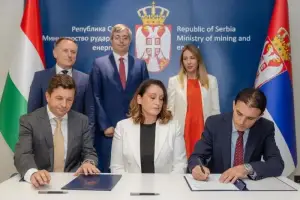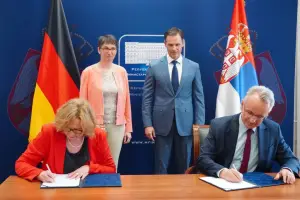Q:
A:
Serbia’s foreign trade in 2006 up 31.2%
Belgrade,
31 January 2007
According to figures from the Serbian Statistics Office, total foreign exchange from January to December last year amounted to more than $19.6 billion, which is an increase of 31.2% compared to the previous year.
Expressed in euros, the figures stand at €15.56 billion, which makes a 29.2% increase compared with 2005.
The value of exports amounted to $6.4 billion, which is a 43.4% increase when compared to the same period of the previous year, while the value of imports amounted to $13.2 billion, which is a 25.9% increase relative to 2005.
Expressed in euros, the value of exports amounted to €5.1 billion, an increase of 41.4% compared year-on-year whereas the value of imports amounted to €10.46 billion, or a 24% increase.
The deficit for the January-December 2006 period was $6.74 billion, an increase of 12.8% in relation to last year. The deficit expressed in euros amounted to 5.36 billion, or an increase of 11% compared with the year before.
The export-import ratio expressed in dollars equaled 48.8% and was higher if compared to the same period previous year when it was 42.8%. Seen in euros, the export-import ratio was 48.8%, and it equaled 42.8% in the same period previous year.
The 2005 data did not include trade with Montenegro, which was part of the union with Serbia at the time.
Increased import was due to import of energy sources, in the total value of $2,605 million, which is 19.8% of entire imports. Increased import was also influenced by import of copper and iron ores as well as increased demand (personal and public consumption), which is because of more accessible loans. Import of road vehicles in 2006 amounted to $953 million, which makes 7.2% of total imports.
Surging exports were also driven by the initial effects of privatisation and the restructuring of companies, by signed and ratified free trade agreements with countries who are signatories of the Stability Pact for South Eastern Europe, and by a food and ready-made textile goods trade surplus, thanks to the agreement signed with the EU.
In the period January–December 2006, the most exported items were intermediate goods, accounting for 67.1 % ($4.31 billion) of overall exports, followed by consumer goods, which made up 27.1% ($1.74 billion) and equipment, making up 5.8 % ($372.5 million) of total exports.
Imports were also dominated by intermediate goods, 62.9 % ($8.28 billion), consumer goods, 21.5 % ($1.81 billion), and equipment, 15.6 % ($2.05 billion) of overall imports.
Major importers of Serbian goods were Italy ($926 million), Bosnia-Herzegovina ($749 million) and Germany ($637 million).
The largest exporters to Serbia were Russia ($2.14 billion), Germany ($1.25 billion) and Italy (nearly $1.1 billion).
The greatest portion of foreign trade was recorded in commerce with the EU, which accounted for more than half of total trade. Serbia achieved surplus of $406 million in trade with Bosnia-Herzegovina and thanks to free trade agreement, as well as the competitiveness of Serbian products a surplus has also been achieved in commerce with Macedonia.
Serbia achieved more balanced foreign trade with Italy than in 2005, whereas the deficit remained wide in commerce with Russia, due to energy imports, mainly oil and natural gas.
According to Standard International Trade Classification (SITC) the most exported items are iron and steel ($872 million), coloured metals ($611 million), vegetables and fruits ($326 million), garments, ($318 million) corn and corn products ($292 million). Export in these five sections made up 37.6% of overall exports.
The top five sectors with largest imports are oil and oil derivatives ($1.634 million), road vehicles ($953 million), natural and industrial gas ($668 million), industrial machines for general use ($594 million) and iron and steel ($536 million) and imports of these articles comprises 33.3% of total imports.
The value of exports amounted to $6.4 billion, which is a 43.4% increase when compared to the same period of the previous year, while the value of imports amounted to $13.2 billion, which is a 25.9% increase relative to 2005.
Expressed in euros, the value of exports amounted to €5.1 billion, an increase of 41.4% compared year-on-year whereas the value of imports amounted to €10.46 billion, or a 24% increase.
The deficit for the January-December 2006 period was $6.74 billion, an increase of 12.8% in relation to last year. The deficit expressed in euros amounted to 5.36 billion, or an increase of 11% compared with the year before.
The export-import ratio expressed in dollars equaled 48.8% and was higher if compared to the same period previous year when it was 42.8%. Seen in euros, the export-import ratio was 48.8%, and it equaled 42.8% in the same period previous year.
The 2005 data did not include trade with Montenegro, which was part of the union with Serbia at the time.
Increased import was due to import of energy sources, in the total value of $2,605 million, which is 19.8% of entire imports. Increased import was also influenced by import of copper and iron ores as well as increased demand (personal and public consumption), which is because of more accessible loans. Import of road vehicles in 2006 amounted to $953 million, which makes 7.2% of total imports.
Surging exports were also driven by the initial effects of privatisation and the restructuring of companies, by signed and ratified free trade agreements with countries who are signatories of the Stability Pact for South Eastern Europe, and by a food and ready-made textile goods trade surplus, thanks to the agreement signed with the EU.
In the period January–December 2006, the most exported items were intermediate goods, accounting for 67.1 % ($4.31 billion) of overall exports, followed by consumer goods, which made up 27.1% ($1.74 billion) and equipment, making up 5.8 % ($372.5 million) of total exports.
Imports were also dominated by intermediate goods, 62.9 % ($8.28 billion), consumer goods, 21.5 % ($1.81 billion), and equipment, 15.6 % ($2.05 billion) of overall imports.
Major importers of Serbian goods were Italy ($926 million), Bosnia-Herzegovina ($749 million) and Germany ($637 million).
The largest exporters to Serbia were Russia ($2.14 billion), Germany ($1.25 billion) and Italy (nearly $1.1 billion).
The greatest portion of foreign trade was recorded in commerce with the EU, which accounted for more than half of total trade. Serbia achieved surplus of $406 million in trade with Bosnia-Herzegovina and thanks to free trade agreement, as well as the competitiveness of Serbian products a surplus has also been achieved in commerce with Macedonia.
Serbia achieved more balanced foreign trade with Italy than in 2005, whereas the deficit remained wide in commerce with Russia, due to energy imports, mainly oil and natural gas.
According to Standard International Trade Classification (SITC) the most exported items are iron and steel ($872 million), coloured metals ($611 million), vegetables and fruits ($326 million), garments, ($318 million) corn and corn products ($292 million). Export in these five sections made up 37.6% of overall exports.
The top five sectors with largest imports are oil and oil derivatives ($1.634 million), road vehicles ($953 million), natural and industrial gas ($668 million), industrial machines for general use ($594 million) and iron and steel ($536 million) and imports of these articles comprises 33.3% of total imports.










